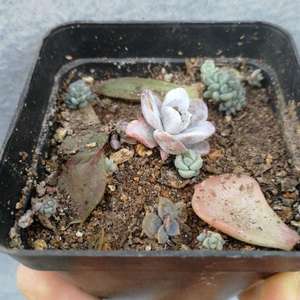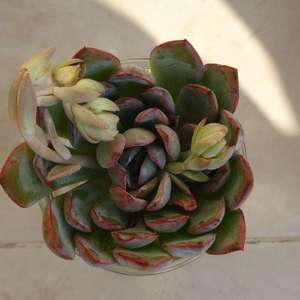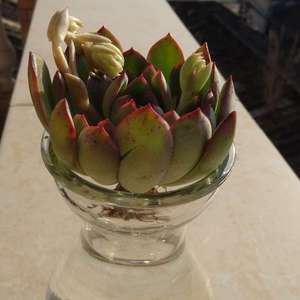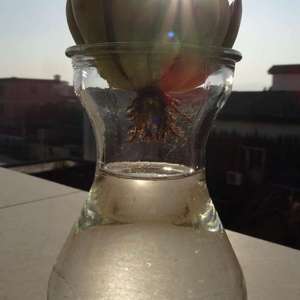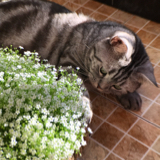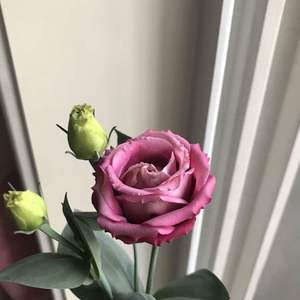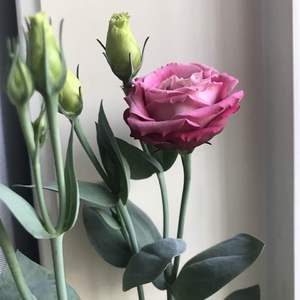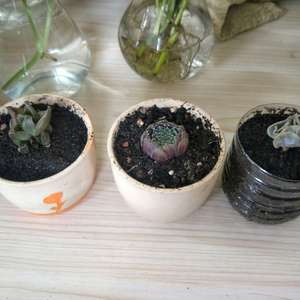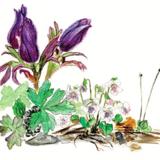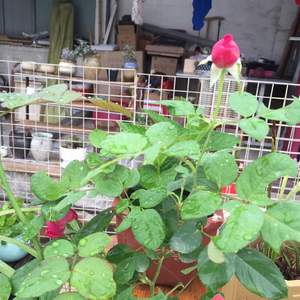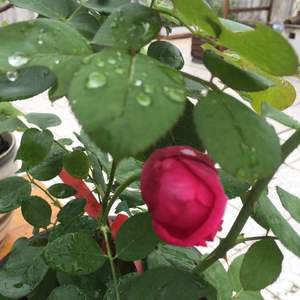求助
胡小林
2018年06月13日

5月18日到6月14日的变化。是否在徒长?该怎么调整?请行家指点!
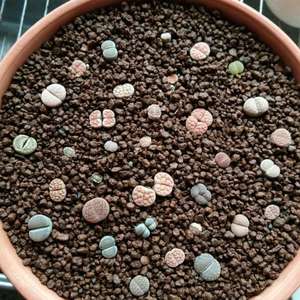
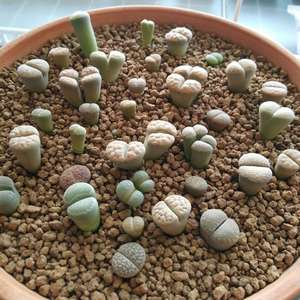


0
0
胡小林:@Fion:光照时长不足,加补光灯吧。谢谢你的指点!
Fion:徒了,减少浇水,拉长浇水间隔,保持每天至少3小时日照。只能不让继续徒,没办法变回原来的样子的啊,这是个人经验,你可以尝试看看
文章
Miss Chen
2018年06月11日

Description: This perennial plant is about 3-5' tall, branching frequently in the upper half. The green stems are glabrous, terete, and slightly ribbed. The alternate leaves are up to 6" long and ¾" across, becoming smaller and more narrow as they ascend the stems. They are narrowly lanceolate to oblanceolate, smooth along their margins, and glabrous; the uppermost leaves are linear. Each leaf tapers gradually to a short petiole-like base. The upper stems terminate in showy panicles of flowerheads; these flowerheads are produced in abundance. Each daisy-like flowerhead is about ¾" across, consisting of about 60 ray florets that surround numerous disk florets. The petaloid rays of the flowerheads are bright white and linear in shape (less often, they are slightly pink or slightly purple), while the tiny tubular corollas of the disk florets are bright yellow. Flowerheads have bases that are shallow and spreading, rather than cylindrically shaped; these bases are covered with overlapping floral bracts (phyllaries) that are light green and narrowly lanceolate in shape. The branching stalks of the panicle are similar to the stems and largely naked, except for narrow leaf-like bracts up to 1" long.
The blooming period occurs from late summer into the fall and lasts about 1 month. The florets are replaced by oblongoid achenes that are somewhat flattened; they are slightly broader at their apices than their bottoms. The apex of each achene has minute scales and a pair of bristles, although the bristles are not always present. The achenes usually fall only a short distance from the mother plant, unless they are carried about by water. The root system sometimes produces stolons that form plantlets at their tips.
Cultivation: The preference is partial or full sun, wet to moist conditions, and a fertile loamy soil. This plant can tolerate standing water for short periods of time and doesn't seem to be bothered by foliar disease to the same extent as many Aster spp. (Asters).

Range & Habitat: The native False Aster occurs occasionally in most areas of Illinois; it is slightly more common in southern Illinois than other areas of the state (see Distribution Map). Habitats include openings in floodplain forests, soggy thickets, alluvial meadows, prairie swales, marshes, and ditches.
Faunal Associations: The flowerheads attract many kinds of insects because their nectar and pollen are readily accessible. These insect visitors include long-tongued bees, short-tongued bees, wasps, flies, butterflies, skippers, moths, and beetles. A dagger bee, Perdita boltoniae, is an oligolege of Boltonia spp. Another bee that is somewhat oligolectic of these species is the long-horned bee, Melissodes boltoniae, which also visits the flowerheads of some Aster spp. False Aster is one of the host plants of a beetle, Microrhopala xerene, whose larvae mine the leaves. The ecological relationships of Boltonia spp. to vertebrate animals are probably similar to those of Aster spp. in wetland areas.

Photographic Location: A prairie swale at Meadowbrook Park in Urbana, Illinois.
Comments: False Aster has attractive foliage and flowers. Different varieties of False Aster have been described; the one that is typically encountered in the state, var. recognita, has flowerheads about ¾" across. In Cook County, var. microcephala also occurs, which has flowerheads that are ½" across or less. While Boltonia spp. (false asters) closely resemble Aster spp. (asters) in appearance, they differ from each other in the following characteristic: The achenes of false asters have minutes scales and/or a pair of bristles at their apices, while the achenes of asters have tufts of hair. As a result, the achenes of asters are carried more readily by the wind into new areas. The other false asters in Illinois are uncommon and differ from Boltonia asteroides by their leaves: Boltonia diffusa interior has linear leaves throughout, while Boltonia decurrens has leaves that are decurrent against their stems (i.e., the base or basal margins of each leaf lies along the surface of the stem).
The blooming period occurs from late summer into the fall and lasts about 1 month. The florets are replaced by oblongoid achenes that are somewhat flattened; they are slightly broader at their apices than their bottoms. The apex of each achene has minute scales and a pair of bristles, although the bristles are not always present. The achenes usually fall only a short distance from the mother plant, unless they are carried about by water. The root system sometimes produces stolons that form plantlets at their tips.
Cultivation: The preference is partial or full sun, wet to moist conditions, and a fertile loamy soil. This plant can tolerate standing water for short periods of time and doesn't seem to be bothered by foliar disease to the same extent as many Aster spp. (Asters).

Range & Habitat: The native False Aster occurs occasionally in most areas of Illinois; it is slightly more common in southern Illinois than other areas of the state (see Distribution Map). Habitats include openings in floodplain forests, soggy thickets, alluvial meadows, prairie swales, marshes, and ditches.
Faunal Associations: The flowerheads attract many kinds of insects because their nectar and pollen are readily accessible. These insect visitors include long-tongued bees, short-tongued bees, wasps, flies, butterflies, skippers, moths, and beetles. A dagger bee, Perdita boltoniae, is an oligolege of Boltonia spp. Another bee that is somewhat oligolectic of these species is the long-horned bee, Melissodes boltoniae, which also visits the flowerheads of some Aster spp. False Aster is one of the host plants of a beetle, Microrhopala xerene, whose larvae mine the leaves. The ecological relationships of Boltonia spp. to vertebrate animals are probably similar to those of Aster spp. in wetland areas.

Photographic Location: A prairie swale at Meadowbrook Park in Urbana, Illinois.
Comments: False Aster has attractive foliage and flowers. Different varieties of False Aster have been described; the one that is typically encountered in the state, var. recognita, has flowerheads about ¾" across. In Cook County, var. microcephala also occurs, which has flowerheads that are ½" across or less. While Boltonia spp. (false asters) closely resemble Aster spp. (asters) in appearance, they differ from each other in the following characteristic: The achenes of false asters have minutes scales and/or a pair of bristles at their apices, while the achenes of asters have tufts of hair. As a result, the achenes of asters are carried more readily by the wind into new areas. The other false asters in Illinois are uncommon and differ from Boltonia asteroides by their leaves: Boltonia diffusa interior has linear leaves throughout, while Boltonia decurrens has leaves that are decurrent against their stems (i.e., the base or basal margins of each leaf lies along the surface of the stem).
0
0
文章
Miss Chen
2018年06月10日

Description: This is a slender, but erect, herbaceous perennial plant that is up to 5' tall. It branches occasionally along the upper half of its length. The green to reddish stems are four-angled, often with white appressed hairs. The opposite leaves are up to 6" long and 1" across. They are lanceolate, conspicuously veined, and their petioles are short. Leaf margins are coarsely serrated. The upper stems terminate in panicles of flowering spikes up to 1' long and about one-half as much across. Individual floral spikes are up to 5" long, and densely crowded all around with numerous blue-violet flowers. Individual flowers are up to ¼" long and similarly across. Each flower has a blue-violet corolla with 5 spreading lobes, a short-tubular calyx with 5 narrow teeth, 4 inserted stamens, and a pistil. The calyx is grayish green to dark red and about one-half as long as the corolla. The blooming period occurs from mid- to late summer, lasting about 1–1½ months. There is no noticeable floral scent. Afterwards, the flowers are replaced by small nutlets (4 nutlets per flower). These nutlets are up to 2 mm. long, reddish brown, and oblongoid in shape. The root system is fibrous and rhizomatous. Small clonal colonies of plants are often produced from the rhizomes.
Floral Spikes

Cultivation: The preference is full to partial sunlight, moist conditions, and soil consisting of fertile loam or wet muck. This plant tolerates standing water if it is temporary. This is a good plant to locate near a small river or pond in a sunny location.
Range & Habitat: Blue Vervain occurs in every county of Illinois (see Distribution Map), where it is fairly common and native. Habitats include riverbottom prairies, moist meadows in floodplain woodlands, soggy thickets, borders of rivers and ponds, marshes, ditches, fence rows, and pastures. This plant adapts readily to degraded wetlands and other disturbed areas, but it can be found in higher quality habitats as well.
Faunal Associations: The flowers of Blue Vervain attract many kinds of long-tongued and short-tongued bees, including honey bees, bumblebees, cuckoo bees (Triepeolus spp.), digger bees (Melissodes spp.), Halictid bees, and dagger bees (Calliopsis spp.), including the oligolectic Verbena Bee (Calliopsis verbenae). These bees seek primarily nectar, although some species collect pollen. Other floral visitors include Sphecid wasps, Vespid wasps, Syrphid flies, bee flies (Exoprosopa spp.), thick-headed flies (Physocephala spp.), small butterflies, skippers, and moths (Robertson, 1929). Other insects feed on the leaves and other parts of Blue Vervain and other Verbena spp. Examples of such insects include both adults and larvae of a flea beetle (Longitarsus suspectus), larvae of the Vervain Leaf Midge (Clinodiplosis verbenae), the Verbena Aphid (Macrosiphum verbenae), leaf-eating larvae of the Verbena Moth (Crambodes talidiformis), and larvae of the Verbena Bud Moth (Endothenia hebesana); see Clark et al. (2004), Felt (1917), Thomas (1877), Covell (1984/2005), and Miller (1987). Mammalian herbivores usually avoid eating this plant because of its bitter leaves – an exception is the Cottontail Rabbit, which may eat the foliage of young plants to a limited extent. Also, various songbirds occasionally eat the seeds, including the Cardinal, Swamp Sparrow, Field Sparrow, Song Sparrow, and Slate-Colored Junco (Martin et al., 1951/1961). Experimental studies have shown that these seeds can pass undamaged through the digestive tracts of cattle, therefore they are probably distributed to some extent by these seed-eating birds.

Photographic Location: The photographs were taken at Meadowbrook Park in Urbana, Illinois.
Comments: The flowers are often a pretty shade of blue-violet, but they are small in size. Among the various Verbena spp. in Illinois, Blue Vervain (Verbena hastata) is easy to identify because it is the only vervain with elegant spikes of flowers in this color range. Other Verbena spp. within the state, excluding introduced cultivated species, have white, pink, or lavender flowers.
Floral Spikes

Cultivation: The preference is full to partial sunlight, moist conditions, and soil consisting of fertile loam or wet muck. This plant tolerates standing water if it is temporary. This is a good plant to locate near a small river or pond in a sunny location.
Range & Habitat: Blue Vervain occurs in every county of Illinois (see Distribution Map), where it is fairly common and native. Habitats include riverbottom prairies, moist meadows in floodplain woodlands, soggy thickets, borders of rivers and ponds, marshes, ditches, fence rows, and pastures. This plant adapts readily to degraded wetlands and other disturbed areas, but it can be found in higher quality habitats as well.
Faunal Associations: The flowers of Blue Vervain attract many kinds of long-tongued and short-tongued bees, including honey bees, bumblebees, cuckoo bees (Triepeolus spp.), digger bees (Melissodes spp.), Halictid bees, and dagger bees (Calliopsis spp.), including the oligolectic Verbena Bee (Calliopsis verbenae). These bees seek primarily nectar, although some species collect pollen. Other floral visitors include Sphecid wasps, Vespid wasps, Syrphid flies, bee flies (Exoprosopa spp.), thick-headed flies (Physocephala spp.), small butterflies, skippers, and moths (Robertson, 1929). Other insects feed on the leaves and other parts of Blue Vervain and other Verbena spp. Examples of such insects include both adults and larvae of a flea beetle (Longitarsus suspectus), larvae of the Vervain Leaf Midge (Clinodiplosis verbenae), the Verbena Aphid (Macrosiphum verbenae), leaf-eating larvae of the Verbena Moth (Crambodes talidiformis), and larvae of the Verbena Bud Moth (Endothenia hebesana); see Clark et al. (2004), Felt (1917), Thomas (1877), Covell (1984/2005), and Miller (1987). Mammalian herbivores usually avoid eating this plant because of its bitter leaves – an exception is the Cottontail Rabbit, which may eat the foliage of young plants to a limited extent. Also, various songbirds occasionally eat the seeds, including the Cardinal, Swamp Sparrow, Field Sparrow, Song Sparrow, and Slate-Colored Junco (Martin et al., 1951/1961). Experimental studies have shown that these seeds can pass undamaged through the digestive tracts of cattle, therefore they are probably distributed to some extent by these seed-eating birds.

Photographic Location: The photographs were taken at Meadowbrook Park in Urbana, Illinois.
Comments: The flowers are often a pretty shade of blue-violet, but they are small in size. Among the various Verbena spp. in Illinois, Blue Vervain (Verbena hastata) is easy to identify because it is the only vervain with elegant spikes of flowers in this color range. Other Verbena spp. within the state, excluding introduced cultivated species, have white, pink, or lavender flowers.
0
0
文章
Miss Chen
2018年06月08日

Description: This annual plant is ½–3' tall, branching sparingly. The central stem is glabrous and occasionally angular. The opposite leaves are up to 5" long and 1" across, although usually smaller in size. They are linear-oblong to lanceolate-ovate, serrated along the margins, and hairless. These leaves are never lobed nor pinnately compound. At the base, the pairs of opposite leaves clasp the stem and nearly surround it (i.e., they're nearly connate), or they are sessile. The upper stems terminate in flowerheads about ½–1½" across. These flowerheads have a tendency to nod downward with age and the central head of disk florets becomes larger and more rounded. The corolla of each disk floret is yellow and narrowly tubular with 5 lobes. There are about 8 ray florets surrounding the disk florets, but sometimes they lack petaloid rays. When they are present, the petaloid rays are bright yellow and oblong-elliptic in shape; they are variable in length, depending on the local ecotype.
At the base of each flowerhead, there are both inner and outer bracts (phyllaries). The inner bracts are pale yellow, membranous along their margins, and rather broad, tapering to blunt tips. The outer bracts are green and oblong-linear. These latter bracts are about as long or longer than the petaloid rays, but they have a tendency to curl backward with age. There are about 6-10 outer bracts per flowerhead. The blooming period occurs from late summer to early fall and lasts about 1-2 months for a colony of plants. Each achene is oblongoid, although broader and somewhat truncated at its apex, where there are usually 4 barbed awns. The root system is shallow and branches frequently. This plant often forms colonies and spreads by reseeding itself; sometimes the lower portion of a stem will form rootlets at the leaf nodes when it lies against moist soil. Nodding Bur-Marigold is rather variable across its range. The leaves have a tendency to turn purple during the cool weather of autumn.

Cultivation: The preference is full or partial sun, wet conditions, and mucky soil. Occasional flooding is readily tolerated, although this species is not an emergent aquatic. Sometimes the leaves succumb to powdery mildew during the fall. This plant is less tolerant of dry conditions than other Bidens spp.
Range & Habitat: The native Nodding Bur-Marigold is common in central and northern Illinois, but occasional to absent in southern Illinois (see Distribution Map). Habitats include swamps, bogs, seeps, marshes, edges of rivers and ponds, soggy meadows in floodplain areas, and ditches along roads and railroads. Nodding Bur-Marigold is often found in degraded wetlands, although it also occurs in higher quality wetlands.

Faunal Associations: Plants with showier flowers attract an abundance of bees, wasps, butterflies, skippers, moths, and various kinds of flies. Bee visitors include honey bees, bumblebees, long-horned bees (Melissodes spp.), leaf-cutting bees (Megachile spp.), and plasterer bees (Colletes spp.). These insects suck nectar from the flowers; bees also collect pollen. The caterpillars of the butterfly Nathalis iole (Dainty Sulfur) feed on the foliage. The caterpillars of several species of moths also feed on Bidens spp., including Epiblema otiosana (Bidens Borer Moth), Cirrhophanus triangulifer (Goldenrod Stowaway), Condica mobilis (Mobile Groundling), and Condica confederata (The Confederate). Other insect feeders the leaf beetles Calligrapha bidenticola and Calligrapha californica, the fruit fly Icterica seriata, and several aphid species.

To a limited extent, the seeds of Bidens spp. are eaten by various kinds of birds, including the Mallard Duck, Swamp Sparrow, Purple Finch, and Common Redpoll (the latter during the winter). The foliage is occasionally eaten by the Cottontail Rabbit. The seeds of Bidens spp. are notorious for their ability to cling to the fur of animals, the feathers of birds, or the clothing of humans, by which means they are distributed far and wide.
Photographic Location: Along a drainage canal in Champaign, Illinois.

Comments: The attractiveness of the flowers is variable, depending upon the length of the petaloid rays, which are not always present. It is fairly easy to distinguish Nodding Bur-Marigold from other Bidens spp. because of its undivided leaves and achenes with 4 awns (rarely fewer). Plants with flowerheads that are large and showy can resemble Bidens laevis (Smooth Bur-Marigold), but this latter species doesn't occur in Illinois. The petaloid rays of Smooth Bur-Marigold are at least as long as the outer floral bracts (phyllaries) and it usually has showier flowers. When the flowerheads of Nodding Bur-Marigold lack petaloid rays, this species can be confused with Bidens connata (Purple-Stemmed Beggar's Tick) and Bidens comosa (Swamp Beggar's Tick). Nodding Bur-Marigold differs from these latter species by its leaves, which are sessile or they clasp and nearly surround the stem. Purple-Stemmed Beggar's Tick and Swamp Beggar's Tick have leaves with distinct petioles that are winged or unwinged. The flowerheads of Nodding Bur-Marigold nod downward with age, while the flowerheads of the latter two species usually remain more erect.
At the base of each flowerhead, there are both inner and outer bracts (phyllaries). The inner bracts are pale yellow, membranous along their margins, and rather broad, tapering to blunt tips. The outer bracts are green and oblong-linear. These latter bracts are about as long or longer than the petaloid rays, but they have a tendency to curl backward with age. There are about 6-10 outer bracts per flowerhead. The blooming period occurs from late summer to early fall and lasts about 1-2 months for a colony of plants. Each achene is oblongoid, although broader and somewhat truncated at its apex, where there are usually 4 barbed awns. The root system is shallow and branches frequently. This plant often forms colonies and spreads by reseeding itself; sometimes the lower portion of a stem will form rootlets at the leaf nodes when it lies against moist soil. Nodding Bur-Marigold is rather variable across its range. The leaves have a tendency to turn purple during the cool weather of autumn.

Cultivation: The preference is full or partial sun, wet conditions, and mucky soil. Occasional flooding is readily tolerated, although this species is not an emergent aquatic. Sometimes the leaves succumb to powdery mildew during the fall. This plant is less tolerant of dry conditions than other Bidens spp.
Range & Habitat: The native Nodding Bur-Marigold is common in central and northern Illinois, but occasional to absent in southern Illinois (see Distribution Map). Habitats include swamps, bogs, seeps, marshes, edges of rivers and ponds, soggy meadows in floodplain areas, and ditches along roads and railroads. Nodding Bur-Marigold is often found in degraded wetlands, although it also occurs in higher quality wetlands.

Faunal Associations: Plants with showier flowers attract an abundance of bees, wasps, butterflies, skippers, moths, and various kinds of flies. Bee visitors include honey bees, bumblebees, long-horned bees (Melissodes spp.), leaf-cutting bees (Megachile spp.), and plasterer bees (Colletes spp.). These insects suck nectar from the flowers; bees also collect pollen. The caterpillars of the butterfly Nathalis iole (Dainty Sulfur) feed on the foliage. The caterpillars of several species of moths also feed on Bidens spp., including Epiblema otiosana (Bidens Borer Moth), Cirrhophanus triangulifer (Goldenrod Stowaway), Condica mobilis (Mobile Groundling), and Condica confederata (The Confederate). Other insect feeders the leaf beetles Calligrapha bidenticola and Calligrapha californica, the fruit fly Icterica seriata, and several aphid species.

To a limited extent, the seeds of Bidens spp. are eaten by various kinds of birds, including the Mallard Duck, Swamp Sparrow, Purple Finch, and Common Redpoll (the latter during the winter). The foliage is occasionally eaten by the Cottontail Rabbit. The seeds of Bidens spp. are notorious for their ability to cling to the fur of animals, the feathers of birds, or the clothing of humans, by which means they are distributed far and wide.
Photographic Location: Along a drainage canal in Champaign, Illinois.

Comments: The attractiveness of the flowers is variable, depending upon the length of the petaloid rays, which are not always present. It is fairly easy to distinguish Nodding Bur-Marigold from other Bidens spp. because of its undivided leaves and achenes with 4 awns (rarely fewer). Plants with flowerheads that are large and showy can resemble Bidens laevis (Smooth Bur-Marigold), but this latter species doesn't occur in Illinois. The petaloid rays of Smooth Bur-Marigold are at least as long as the outer floral bracts (phyllaries) and it usually has showier flowers. When the flowerheads of Nodding Bur-Marigold lack petaloid rays, this species can be confused with Bidens connata (Purple-Stemmed Beggar's Tick) and Bidens comosa (Swamp Beggar's Tick). Nodding Bur-Marigold differs from these latter species by its leaves, which are sessile or they clasp and nearly surround the stem. Purple-Stemmed Beggar's Tick and Swamp Beggar's Tick have leaves with distinct petioles that are winged or unwinged. The flowerheads of Nodding Bur-Marigold nod downward with age, while the flowerheads of the latter two species usually remain more erect.
0
0
文章
Miss Chen
2018年06月08日

Description: This perennial wildflower is 2½–5' tall. The stout central stem is unbranched, terete, and light green, reddish green, or brownish green; it is covered with long hairs that are white or light brown. Along each stem, there are widely spreading alternate leaves. These leaves are odd-pinnate and up to 2' long and ½' across; each leaf has 9-17 primary leaflets and smaller secondary leaflets. The secondary leaflets are located between pairs of primary leaflets. Individual primary leaflets are 2-3" long and about one-third as much across; they are narrowly lanceolate, narrowly oblanceolate, or elliptic with wedge-shaped bottoms and acute tips. Leaflet margins are coarsely dentate. The upper surface of each leaflet is yellowish green and hairless, while the lower surface is short-pubescent. Secondary leaflets are similar to the primary leaflets, but they are much smaller in size (less than 1" long). Both the petiole and rachis of each compound leaf are pubescent; quite often, they have sparse long hairs. At the base of each leaf, there is a pair of large stipules that are fan-shaped and either coarsely dentate or cleft with pointed lobes.
The central stem terminates in a long spike-like raceme about ¾–2½' long. Robust plants also produce secondary racemes from the axils of the upper leaves that are shorter than the terminal raceme. These racemes are usually more or less erect, although longer racemes sometimes bend sideways to become nearly horizontal with the ground. The central stalk of the raceme is light green, terete, and short-pubescent. Numerous small flowers about ¼" across occur along the length of the raceme on short stalks about 1/8" long. Individual flowers consist of a tubular green calyx, 5 yellow petals, about 10 stamens, and a central pistil. The tubular calyx is turbinate in shape and 10-ribbed. The blooming period occurs from mid- to late summer and lasts about 1-2 months. Afterwards, the flowers are replaced by 1-2 seeded fruits about ¼" across. These small fruits have numerous hooked prickles along the upper rims of their persistent calyxes. Immature fruits are green, while mature fruits are brown. The root system is fibrous and rhizomatous. Clonal colonies of plants are often produced.

Cultivation: Swamp Agrimony prefers full sun to light shade, moist conditions, and loamy, silty, gravelly, or sandy soil. It tolerates temporary flooding during the spring.
Range & Habitat: Swamp Agrimony is occasional throughout Illinois (see Distribution Map), where it is native. Habitats include openings in floodplain woodlands, swamps, soggy thickets, gravelly seeps, riverbottom prairies and prairie swales, and roadside ditches. The preceding habitats can be either sandy or non-sandy.

Faunal Associations: The nectar and pollen of the flowers attract small bees and flower flies (Syrphidae). Larvae of the midge, Contarinia agrimoniae, feed on the flower buds, flowers, & developing seeds of Agrimonia spp. and other species in the Rose family, while an aphid, Macrosiphum agrimoniellum, sucks juices from the flowering stems. Insects that feed on the foliage of Agrimonia spp. include larvae of a sawfly (Fenella nigrita), larvae of a Gelechiid moth (Anacampsis agrimoniella), and larvae of a Tischeriid moth (Coptotriche agrimoniella). Because the foliage is bitter-tasting and high in tannins, it is usually avoided by mammalian herbivores. The bur-like fruits can cling to the fur of mammals, the feathers of birds, and the clothing of humans, which spreads the seeds to new locations.

Photographic Location: Near Cowle's Bog at the Indiana Dunes National Lakeshore in NW Indiana, where it was moist, partially shaded, and sandy.
Comments: Compared to other Agrimonia spp. in Illinois, Swamp Agrimony is easy to identify because its compound leaves have more primary leaflets (9-17) and its primary leaflets are more narrow in shape. To a greater extent than other species in this genus, Swamp Agrimony prefers habitats that are sunny and wet. Only a few flowers are in bloom at the same time; they are short-lived and not very showy because of their small size.
The central stem terminates in a long spike-like raceme about ¾–2½' long. Robust plants also produce secondary racemes from the axils of the upper leaves that are shorter than the terminal raceme. These racemes are usually more or less erect, although longer racemes sometimes bend sideways to become nearly horizontal with the ground. The central stalk of the raceme is light green, terete, and short-pubescent. Numerous small flowers about ¼" across occur along the length of the raceme on short stalks about 1/8" long. Individual flowers consist of a tubular green calyx, 5 yellow petals, about 10 stamens, and a central pistil. The tubular calyx is turbinate in shape and 10-ribbed. The blooming period occurs from mid- to late summer and lasts about 1-2 months. Afterwards, the flowers are replaced by 1-2 seeded fruits about ¼" across. These small fruits have numerous hooked prickles along the upper rims of their persistent calyxes. Immature fruits are green, while mature fruits are brown. The root system is fibrous and rhizomatous. Clonal colonies of plants are often produced.

Cultivation: Swamp Agrimony prefers full sun to light shade, moist conditions, and loamy, silty, gravelly, or sandy soil. It tolerates temporary flooding during the spring.
Range & Habitat: Swamp Agrimony is occasional throughout Illinois (see Distribution Map), where it is native. Habitats include openings in floodplain woodlands, swamps, soggy thickets, gravelly seeps, riverbottom prairies and prairie swales, and roadside ditches. The preceding habitats can be either sandy or non-sandy.

Faunal Associations: The nectar and pollen of the flowers attract small bees and flower flies (Syrphidae). Larvae of the midge, Contarinia agrimoniae, feed on the flower buds, flowers, & developing seeds of Agrimonia spp. and other species in the Rose family, while an aphid, Macrosiphum agrimoniellum, sucks juices from the flowering stems. Insects that feed on the foliage of Agrimonia spp. include larvae of a sawfly (Fenella nigrita), larvae of a Gelechiid moth (Anacampsis agrimoniella), and larvae of a Tischeriid moth (Coptotriche agrimoniella). Because the foliage is bitter-tasting and high in tannins, it is usually avoided by mammalian herbivores. The bur-like fruits can cling to the fur of mammals, the feathers of birds, and the clothing of humans, which spreads the seeds to new locations.

Photographic Location: Near Cowle's Bog at the Indiana Dunes National Lakeshore in NW Indiana, where it was moist, partially shaded, and sandy.
Comments: Compared to other Agrimonia spp. in Illinois, Swamp Agrimony is easy to identify because its compound leaves have more primary leaflets (9-17) and its primary leaflets are more narrow in shape. To a greater extent than other species in this genus, Swamp Agrimony prefers habitats that are sunny and wet. Only a few flowers are in bloom at the same time; they are short-lived and not very showy because of their small size.
0
0
文章
Miss Chen
2018年06月07日

Description: This perennial herbaceous plant has petioled basal leaves up to 6" (15 cm.) tall. The basal leaves are trifoliate and usually evergreen. The petioles of these leaves are 2-6" (5-15 cm.) long, more or less erect, light green, terete, and sparsely to moderately hairy. Individual leaflets of basal leaves are 1-3" long and a little less across; they are broadly obovate overall and wedge-shaped (cuneate) at the base. The margins of these leaflets are sharply divided (cleft) into shallow to moderately deep rounded lobes, and often slightly ciliate; the middle to outer margins are coarsely serrated or dentate. The upper leaf surface is medium to dark green (becoming dark purplish red during the winter), while the lower leaf surface is a slightly lighter shade of green. Both leaf surfaces are sparsely short-hairy. The leaflets are either sessile or they have short petiolules (basal stalklets).
Occasionally, small cymes of 3-7 flowers are produced directly from the root system. These inflorescences are about as tall as the petioled basal leaves or a little taller. The peduncle, its branches, and pedicels of an inflorescence are light green, sparsely to moderately hairy, and rather slender. Narrow leafy bracts up to ½" in length occur where the branches of the peduncle and the pedicels diverge from each other. Pedicels of the flowers are up to ½" in length. Individual flowers are ½–¾" across, consisting of 5 yellow petals, 5 light green sepals that are joined together at the base, a dense ring of 40 or more stamens with yellow anthers, and a small central cluster of 2-6 carpels with slender styles. The petals are elliptic to broadly elliptic in shape and widely spreading; they are longer than the sepals. The sepals are sparsely to moderately hairy and deltate (triangular) in shape. The blooming period usually occurs intermittently from late spring to early summer, lasting about 1 month. The petals fall from the flowers after only 1 or 2 days. Afterwards, the carpels (pistils) mature into flattened achenes about 2 mm. in length. (one achene per carpel); these achenes are finelyDistribution Map short-hairy. Prior to the maturity of the achenes, the styles break off from their achenes at the base. These styles lack hooks. The root system has shallow reddish rhizomes and secondary fibrous roots. Clonal colonies of plants of varying size are produced from the rhizomes; this is the primary method of reproduction.
Cultivation: The preference is partial sunlight to light shade, more or less mesic conditions, and soil containing rocky material, clay, loam, or humus. The soil pH should be moderately acidic to neutral (5.5–7.0). This plant dislikes hot summer weather and it requires some protection from the afternoon sun. In Illinois, areas with reduced competition from heavy leaf-fall and other ground vegetation are preferred.
Habitats: Barren Strawberry (Waldsteinia fragarioides) has been found only once in Illinois as a wild plant in Pope County, where it is regarded as a native wildflower. As a result, it has been listed as 'state-endangered.' Because this isolated population has not been relocated since its discovery, it is possible that Barren Strawberry has been extirpated from the state. The primary range of this wildflower occurs in the Appalachian Mountains and boreal areas of NE USA, the upper Midwest, and adjacent areas of southern Canada. In Illinois, this wildflower is most likely to occur in such habitats as sandstone or limestone ledges with thin layers of soil and humus, the rocky banks of woodland streams, and the rocky sides of wooded bluffs, especially if they face toward the north or east. So far, Barren Strawberry has occurred only in a high quality natural area of the state.
Faunal Associations: Very little is known about floral-faunal relationships for this wildflower. Andrenid bees (Andrena spp.) have been observed to visit the flowers for nectar and/or pollen (Krombein et al., 1979); it is likely that other small bees and other small insects visit the flowers as well. It has been reported that White-tailed Deer avoid browsing on the foliage (Hill, 2003).
Photographic Location: The wildflower garden of the webmaster in Urbana, Illinois.

Comments: The leaves of Barren Strawberry (Waldsteinia fragarioides) superficially resemble those of Wild Strawberry (Fragaria virginiana), but it produces dry achenes rather than colorful fruits and yellow flowers rather than white flowers. This native wildflower should not be confused with a very similar species that is often cultivated in ornamental gardens, namely the Siberian Barren Strawberry (Waldsteinia ternata). Many mass-market nurseries that claim to be selling the native Barren Strawberry are actually selling this latter species instead. The native Barren Strawberry differs from the latter species in the following ways: 1) its flowers have more narrow petals than the latter species, 2) there are no bractlets on its sepals, unlike the latter species, and 3) its leaflets are less deeply divided into lobes than the latter species. The light green bractlets on the sepals of Siberian Barren Strawberry are about one-third to one-half of the length of its sepals, and they are either linear or narrowly lanceolate in shape. Solitary bractlets occur between each pair of sepals. The petals of Siberian Barren Strawberry are oval to nearly orbicular in shape; adjacent petals on its flowers frequently overlap each other. Recently, some botanists have reassigned the native Barren Strawberry to another genus on the basis of genetic evidence. As a result, it is sometimes referred to as Geum fragarioides. Unlike most native Geum spp., however, the styles of native Barren Strawberry are neither persistent nor hooked. This means that animals and birds are unlikely to be important agents in the dispersal of its seeds. Another common name for this native species is Appalachian Barren Strawberry.
Occasionally, small cymes of 3-7 flowers are produced directly from the root system. These inflorescences are about as tall as the petioled basal leaves or a little taller. The peduncle, its branches, and pedicels of an inflorescence are light green, sparsely to moderately hairy, and rather slender. Narrow leafy bracts up to ½" in length occur where the branches of the peduncle and the pedicels diverge from each other. Pedicels of the flowers are up to ½" in length. Individual flowers are ½–¾" across, consisting of 5 yellow petals, 5 light green sepals that are joined together at the base, a dense ring of 40 or more stamens with yellow anthers, and a small central cluster of 2-6 carpels with slender styles. The petals are elliptic to broadly elliptic in shape and widely spreading; they are longer than the sepals. The sepals are sparsely to moderately hairy and deltate (triangular) in shape. The blooming period usually occurs intermittently from late spring to early summer, lasting about 1 month. The petals fall from the flowers after only 1 or 2 days. Afterwards, the carpels (pistils) mature into flattened achenes about 2 mm. in length. (one achene per carpel); these achenes are finelyDistribution Map short-hairy. Prior to the maturity of the achenes, the styles break off from their achenes at the base. These styles lack hooks. The root system has shallow reddish rhizomes and secondary fibrous roots. Clonal colonies of plants of varying size are produced from the rhizomes; this is the primary method of reproduction.
Cultivation: The preference is partial sunlight to light shade, more or less mesic conditions, and soil containing rocky material, clay, loam, or humus. The soil pH should be moderately acidic to neutral (5.5–7.0). This plant dislikes hot summer weather and it requires some protection from the afternoon sun. In Illinois, areas with reduced competition from heavy leaf-fall and other ground vegetation are preferred.
Habitats: Barren Strawberry (Waldsteinia fragarioides) has been found only once in Illinois as a wild plant in Pope County, where it is regarded as a native wildflower. As a result, it has been listed as 'state-endangered.' Because this isolated population has not been relocated since its discovery, it is possible that Barren Strawberry has been extirpated from the state. The primary range of this wildflower occurs in the Appalachian Mountains and boreal areas of NE USA, the upper Midwest, and adjacent areas of southern Canada. In Illinois, this wildflower is most likely to occur in such habitats as sandstone or limestone ledges with thin layers of soil and humus, the rocky banks of woodland streams, and the rocky sides of wooded bluffs, especially if they face toward the north or east. So far, Barren Strawberry has occurred only in a high quality natural area of the state.
Faunal Associations: Very little is known about floral-faunal relationships for this wildflower. Andrenid bees (Andrena spp.) have been observed to visit the flowers for nectar and/or pollen (Krombein et al., 1979); it is likely that other small bees and other small insects visit the flowers as well. It has been reported that White-tailed Deer avoid browsing on the foliage (Hill, 2003).
Photographic Location: The wildflower garden of the webmaster in Urbana, Illinois.

Comments: The leaves of Barren Strawberry (Waldsteinia fragarioides) superficially resemble those of Wild Strawberry (Fragaria virginiana), but it produces dry achenes rather than colorful fruits and yellow flowers rather than white flowers. This native wildflower should not be confused with a very similar species that is often cultivated in ornamental gardens, namely the Siberian Barren Strawberry (Waldsteinia ternata). Many mass-market nurseries that claim to be selling the native Barren Strawberry are actually selling this latter species instead. The native Barren Strawberry differs from the latter species in the following ways: 1) its flowers have more narrow petals than the latter species, 2) there are no bractlets on its sepals, unlike the latter species, and 3) its leaflets are less deeply divided into lobes than the latter species. The light green bractlets on the sepals of Siberian Barren Strawberry are about one-third to one-half of the length of its sepals, and they are either linear or narrowly lanceolate in shape. Solitary bractlets occur between each pair of sepals. The petals of Siberian Barren Strawberry are oval to nearly orbicular in shape; adjacent petals on its flowers frequently overlap each other. Recently, some botanists have reassigned the native Barren Strawberry to another genus on the basis of genetic evidence. As a result, it is sometimes referred to as Geum fragarioides. Unlike most native Geum spp., however, the styles of native Barren Strawberry are neither persistent nor hooked. This means that animals and birds are unlikely to be important agents in the dispersal of its seeds. Another common name for this native species is Appalachian Barren Strawberry.
0
0
成长记
辣木姐--璐颖
2018年06月01日

摔了一次,断了5个头,现在变绿了
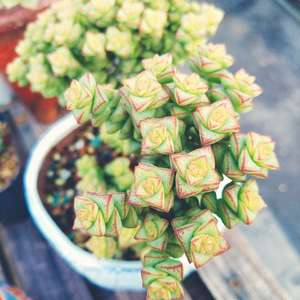

0
0
辣木姐--璐颖:@less is more 实在不行只能砍了
less is more:我的小米星茎部木质化严重,感觉整株干干的,怎么让它变一大盆



